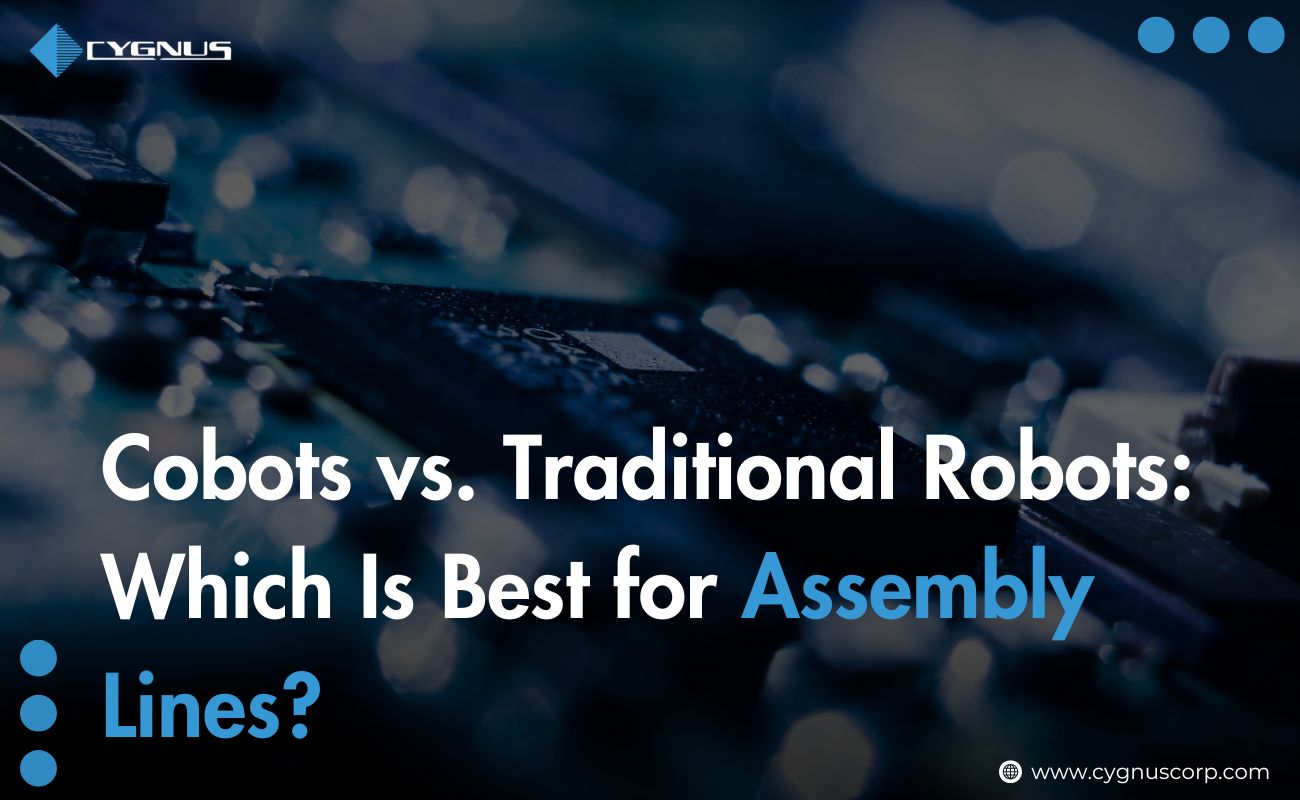As manufacturing evolves, factory automation with robots is reshaping how products are assembled, packaged, and shipped. Today, manufacturers have more choices than ever—especially when deciding between cobots vs traditional robots. But which option is best for modern assembly lines? Let’s explore the definitions, key differences, real-world examples, and future trends in this rapidly changing field.
What Are Cobots?
Cobots, or collaborative robots, are designed to work side by side with human operators on the factory floor. Their key features include advanced safety systems, force sensors, and lightweight builds, which make them flexible and safe for direct human interaction. This means they can perform tasks like assembly, quality control, or packaging right next to a person—without the need for bulky safety barriers.
Cobots for assembly lines are becoming increasingly popular in industries with high product variability, frequent changeovers, or where repetitive tasks can be easily automated but still require a human touch. They are especially valuable in small-batch production, electronics, automotive components, and consumer goods.
What Are Traditional Robots?
Traditional robots in manufacturing are the classic, heavy-duty machines that have powered industrial automation for decades. These robots excel at speed, power, and precision, but are typically separated from human workers by safety cages or barriers. Their design allows them to handle large payloads and perform the same motion thousands of times without error.
You’ll find traditional robots in manufacturing applications such as car assembly, welding, painting, or heavy lifting—tasks that demand high volume, consistency, and minimal human interaction.
Key Differences Between Cobots and Traditional Robots
Safety and Human Collaboration:
Cobots vs traditional robots: The biggest difference is how they interact with people. Cobots for assembly lines are built to collaborate safely with humans, using sensors and smart controls to stop instantly if there’s contact. On the other hand, traditional robots in manufacturing require strict isolation to prevent accidents, since they move fast and are not designed for close human proximity.
Flexibility and Ease of Programming:
Collaborative robots assembly line systems stand out for their ease of use. Cobots can often be reprogrammed or repositioned by line workers without expert knowledge. This makes them ideal for factories with frequent product changes.
In contrast, traditional robots are best suited for repetitive, high-volume operations where their programming rarely changes. Adjusting a traditional robot usually requires skilled technicians and downtime.
Cost and ROI:
When comparing cobots vs traditional robots, cost is a major factor. Cobots tend to have lower initial investments and are more cost-effective for small to mid-sized operations that need flexibility. Their ability to share workspace with humans also saves valuable floor space and reduces facility costs.
Traditional robots in manufacturing typically require larger investments, including safety infrastructure and maintenance. However, they offer unmatched throughput in high-volume environments, often justifying their higher price tag for large manufacturers.
Speed, Power, and Precision:
Factory automation with robots often relies on speed and payload capacity. Here, traditional robots outperform cobots—they can work faster, carry heavier loads, and deliver ultra-precise results. Cobots, while not as fast or powerful, excel at tasks requiring dexterity, adaptability, and safe collaboration.
Choosing the Right Solution for Your Assembly Line
When to Choose Cobots?
Cobots for assembly lines are ideal when:
- Your production involves frequent changes or customizations.
- You need human workers and robots to collaborate closely.
- Floor space is limited, and safety is a top concern.
- You’re looking for a fast ROI with low upfront costs.
When to Choose Traditional Robots?
Traditional robots in manufacturing are best when:
- High-speed, repetitive tasks dominate your workflow.
- Heavy lifting or hazardous processes are involved.
- Your facility is optimized for fully automated, high-volume production.
- Consistency and speed are critical to your business.
Case Studies: Real-World Examples
- Electronics Factory: An electronics firm integrated cobots for assembly lines to handle delicate wiring and inspection. Workers and cobots worked side-by-side, increasing productivity by 25% while reducing errors.
- Automotive Plant: A car manufacturer deployed traditional robots in manufacturing to automate welding and painting. The result: higher throughput and consistent quality, but with significant investment in safety barriers and programming.
These examples show that both collaborative robots assembly line setups and traditional robots can dramatically boost efficiency—when chosen to match specific factory needs.
The Future of Automation in Assembly Lines:
The future is about synergy. Factory automation with robots is moving towards smart integration, where AI, IoT, and machine learning enable robots and cobots to work together—and with humans—more intelligently than ever. The lines between cobots vs traditional robots will continue to blur, making assembly lines more flexible, productive, and safe.
Conclusion:
Both cobots and traditional robots are transforming factory automation with robots. Your best choice depends on your unique requirements: for high flexibility and safe human collaboration, cobots for assembly lines are hard to beat. For maximum speed and volume, traditional robots in manufacturing remain essential. Evaluate your workflow, goals, and budget to find the ideal automation solution for your assembly line.
FAQs
1. What is the main difference between a cobot and a traditional robot?
Cobots are designed for safe, direct collaboration with humans and are typically more flexible, while traditional robots are faster, more powerful, and usually operate in isolation.
2. Are cobots safe to work alongside human operators?
Yes. Cobots have advanced sensors and control systems to ensure safety, stopping automatically if contact with a human is detected.
3. Which type of robot is more cost-effective for small manufacturers?
Cobots generally offer a lower initial investment, faster ROI, and more flexibility for small and medium-sized factories.
4. Can traditional robots be upgraded to work collaboratively like cobots?
Some traditional robots can be retrofitted with safety features, but true collaborative robots are specifically designed for safe interaction and ease of use alongside humans.




